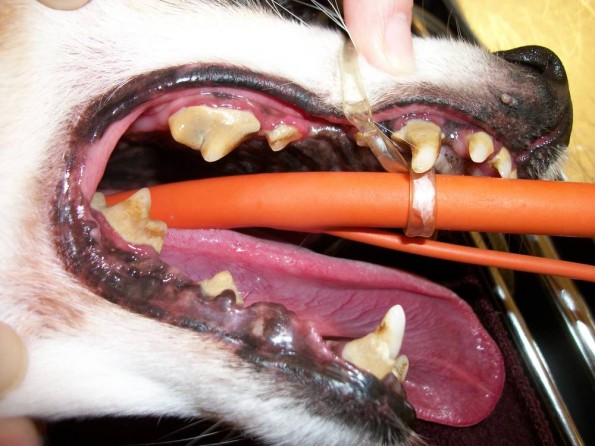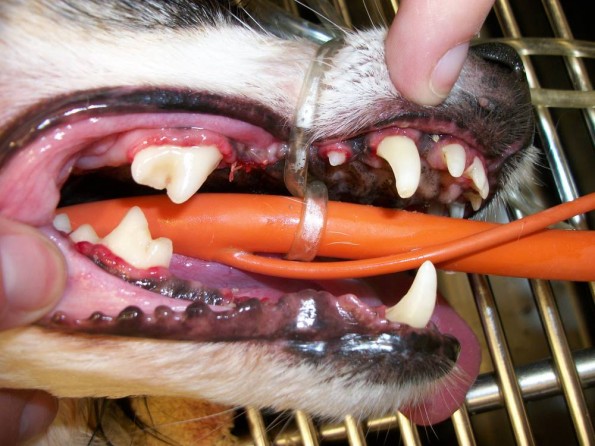What is periodontal (dental) disease?
Periodontal disease is a term used to describe inflammation or infection of the tissues surrounding the tooth. Accumulation of tartar and calculus on the teeth causes gum recession around the base of the tooth. Infection soon follows and the gums recede further, exposing sensitive unprotected tooth root surfaces and the bony tooth sockets Left untreated, the infection spreads deep into the tooth socket, destroying the bone. Ultimately, the tooth loosens and falls out.
How does tartar form and why is it a problem?
The mouth is home to thousands of bacteria. As these bacteria multiply on the surfaces of the tooth, they form an invisible layer called plaque or biofilm. Some of this plaque is removed naturally by the dog’s tongue and chewing habits. If allowed to remain on the tooth surface, the plaque thickens and becomes mineralized. Mineralized plaque forms tartar and as the tartar thickens further it becomes calculus. The tartar accumulates above and below the gumline and presses on the gums, causing inflammation called gingivitis.
As the oral infection progresses, tonsillitis and pharyngitis can also occur. The bacteria can also be absorbed into the blood stream and be carried to other organs. “Bad teeth” can cause infections in the heart valves (endocarditis), kidneys and/or liver.
How common is dental disease?
Very common. Studies have shown that over two-thirds of pets over 3 years of age have some degree of periodontal disease, making it the most common disease affecting our pets.
SIGNS & SYMPTOMS OF POOR ORAL HEALTH
Persistent bad breath
Plaque (often not visible unless stained)
Tartar (creamy-brown, hard material)
Bleeding, inflamed or receded gums
Sensitivity around the mouth
Pawing at the mouth
Loose or missing teeth
Difficulty eating and chewing food
Loss of appetite
How can I prevent tartar from building up on my pet’s teeth?
Plaque becomes mineralized in some dogs much quicker than in others.
The best way to prevent tartar build-up is regular home care, particularly tooth brushing using toothpaste that is specifically designed to be swallowed. Special dog chew toys and treats may help reduce or delay tartar build-up. Some pet foods have been specifically formulated as dental diets that mechanically assist in plaque removal. Next week’s blog touches more on home care, so stay tuned…
What is a professional dental cleaning?
A routine dental cleaning involves a thorough dental examination, followed by a dental scaling and polishing to remove the tartar and invisible plaque from all of the tooth surfaces. Your veterinarian will perform pre-anesthetic blood tests to ensure that kidney and liver function are satisfactory for anesthesia. Sometimes antibiotic treatment is started before the periodontal therapy is performed. Your veterinarian will discuss the specific pre-dental recommendations for your pet.
Once your dog is anesthetized, your veterinarian will thoroughly examine the mouth, noting the alignment of the teeth and the extent of tartar accumulation both above and below the gumline. If periodontal disease is severe, it may not be possible to save badly affected teeth, which may need to be extracted. Next, tooth scaling will be performed using both traditional hand scalers and ultrasonic cleaning equipment to remove all traces of tartar, both above and below the gum line. The tartar below the gum line causes the most significant gum recession and it is extremely important that it is removed thoroughly. After scaling, the teeth are polished to remove microscopic scratches in order to help prevent subsequent plaque build-up. Special applications such as fluoride, antibiotic preparations and cleaning compounds may be indicated to decrease tooth sensitivity, strengthen enamel, treat bacterial infection and reduce future plaque accumulation.
The procedures that your pet may require will be discussed with you before your pet’s dental cleaning. Since it can be difficult to predict the extent of dental disease in advance of the procedure, it is imperative that your veterinarian is able to reach you during the procedure to discuss any additional treatment that may be necessary.



